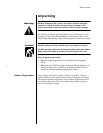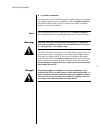
12
Mark Levinson
Extensive Protection
The Nº433 is designed to shut itself down if it senses any of a
number of fault conditions that could cause damage to itself or to
associated loudspeakers.
These fault conditions include:
• the presence of DC (direct current) at the output
• demand for excessive current at the output, indicating a short-
circuit
• over-voltage or under-voltage conditions (+/-10%) at the ~ac
mains connector
• unsafe operating temperatures in any of several critical areas
within the amplifier
In the case of either significant DC offset or an over-current
condition, the amplifier will shut down to protect itself and the
associated loudspeakers. The front panel indicator LED will blink
rapidly, remaining lit about half of the time. To restore normal
operation, power-down the amplifier using the power button,
remove the cause of the fault, and wait five minutes before
powering the amplifier back on.
If the ~ac mains connector voltage is too high or too low for safe
operation, the amplifier will automatically enter sleep mode and
the front panel indicator LED will blink rapidly, remaining on most
of the time. The amplifier will not come out of sleep mode until the
~ac mains connector voltage is again within the normal operating
range. For example, a 120V amplifier will operate between approxi-
mately 108-132VAC; a 230V amplifier will operate between
approximately 207-253VAC. Outside of these generous limits, the
amplifier will enter sleep mode. Once the fault condition is
removed, the amplifier can be taken out of sleep mode.
If the amplifier overheats despite its innovative heat sinking and
cooling system, it will enter and remain in sleep mode until the
temperature at the output heat sinks drops below 85°C (158°F or
358K). The front panel indicator LED will blink rapidly, remaining
unlit most of the time. Once the fault condition is removed, the
amplifier can be taken out of sleep mode.
In addition, the AC input to each transformer is fused to protect
against excessive current conditions such as driving shorted
outputs. Inrush limiting prevents premature aging of power supply
components during power-up and switches off-line once the power
supply has been charged.
Finally, the amplifier incorporates a controlled clipping circuit that
prevents the output devices from saturating. The harsh, high-
frequency harmonics generated by hard-clipped output devices are
avoided by the wave-shaping action of the controlled clip circuitry.


















